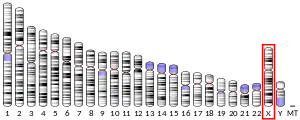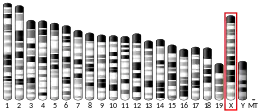RPS6KA3
protein S6 kinase, 90kDa, polypeptide 3, also s RPS6KA3, is an enzyme that in humans is encoded by the RPS6KA3 gene.[5][6]
Function
This gene encodes a member of the RSK (ribosomal S6 kinase) family of serine/threonine kinases. This kinase contains 2 non-identical kinase catalytic domains and phosphorylates various substrates, including members of the mitogen-activated kinase (MAPK) signalling pathway. The activity of this protein has been implicated in controlling cell growth and differentiation.[5]
Clinical significance
Mutations in this gene have been associated with Coffin–Lowry syndrome (CLS).[7]
Interactions
RPS6KA3 has been shown to interact with CREB-binding protein,[8] MAPK1[9][10] and PEA15.[11]
References
- GRCh38: Ensembl release 89: ENSG00000177189 - Ensembl, May 2017
- GRCm38: Ensembl release 89: ENSMUSG00000031309 - Ensembl, May 2017
- "Human PubMed Reference:". National Center for Biotechnology Information, U.S. National Library of Medicine.
- "Mouse PubMed Reference:". National Center for Biotechnology Information, U.S. National Library of Medicine.
- "Entrez Gene: RPS6KA3 ribosomal protein S6 kinase, 90kDa, polypeptide 3".
- Moller DE, Xia CH, Tang W, Zhu AX, Jakubowski M (February 1994). "Human rsk isoforms: cloning and characterization of tissue-specific expression". The American Journal of Physiology. 266 (2 Pt 1): C351–9. doi:10.1152/ajpcell.1994.266.2.C351. PMID 8141249.
- Jacquot S, Zeniou M, Touraine R, Hanauer A (January 2002). "X-linked Coffin-Lowry syndrome (CLS, MIM 303600, RPS6KA3 gene, protein product known under various names: pp90(rsk2), RSK2, ISPK, MAPKAP1)". European Journal of Human Genetics. 10 (1): 2–5. doi:10.1038/sj.ejhg.5200738. PMID 11896450.
- Merienne K, Pannetier S, Harel-Bellan A, Sassone-Corsi P (October 2001). "Mitogen-regulated RSK2-CBP interaction controls their kinase and acetylase activities". Molecular and Cellular Biology. 21 (20): 7089–96. doi:10.1128/MCB.21.20.7089-7096.2001. PMC 99884. PMID 11564891.
- Zhao Y, Bjorbaek C, Moller DE (November 1996). "Regulation and interaction of pp90(rsk) isoforms with mitogen-activated protein kinases". The Journal of Biological Chemistry. 271 (47): 29773–9. doi:10.1074/jbc.271.47.29773. PMID 8939914.
- Smith JA, Poteet-Smith CE, Malarkey K, Sturgill TW (January 1999). "Identification of an extracellular signal-regulated kinase (ERK) docking site in ribosomal S6 kinase, a sequence critical for activation by ERK in vivo". The Journal of Biological Chemistry. 274 (5): 2893–8. doi:10.1074/jbc.274.5.2893. PMID 9915826.
- Vaidyanathan H, Ramos JW (August 2003). "RSK2 activity is regulated by its interaction with PEA-15". The Journal of Biological Chemistry. 278 (34): 32367–72. doi:10.1074/jbc.M303988200. PMID 12796492.
Further reading
- Omary MB, Baxter GT, Chou CF, Riopel CL, Lin WY, Strulovici B (May 1992). "PKC epsilon-related kinase associates with and phosphorylates cytokeratin 8 and 18". The Journal of Cell Biology. 117 (3): 583–93. doi:10.1083/jcb.117.3.583. PMC 2289443. PMID 1374067.
- Ku NO, Omary MB (October 1994). "Identification of the major physiologic phosphorylation site of human keratin 18: potential kinases and a role in filament reorganization". The Journal of Cell Biology. 127 (1): 161–71. doi:10.1083/jcb.127.1.161. PMC 2120194. PMID 7523419.
- Adams MD, Kerlavage AR, Fleischmann RD, Fuldner RA, Bult CJ, Lee NH, Kirkness EF, Weinstock KG, Gocayne JD, White O (September 1995). "Initial assessment of human gene diversity and expression patterns based upon 83 million nucleotides of cDNA sequence" (PDF). Nature. 377 (6547 Suppl): 3–174. PMID 7566098.
- Zhao Y, Bjørbaek C, Weremowicz S, Morton CC, Moller DE (August 1995). "RSK3 encodes a novel pp90rsk isoform with a unique N-terminal sequence: growth factor-stimulated kinase function and nuclear translocation". Molecular and Cellular Biology. 15 (8): 4353–63. doi:10.1128/MCB.15.8.4353. PMC 230675. PMID 7623830.
- Bjørbaek C, Vik TA, Echwald SM, Yang PY, Vestergaard H, Wang JP, Webb GC, Richmond K, Hansen T, Erikson RL (January 1995). "Cloning of a human insulin-stimulated protein kinase (ISPK-1) gene and analysis of coding regions and mRNA levels of the ISPK-1 and the protein phosphatase-1 genes in muscle from NIDDM patients". Diabetes. 44 (1): 90–7. doi:10.2337/diabetes.44.1.90. PMID 7813820.
- Donnelly AJ, Choo KH, Kozman HM, Gedeon AK, Danks DM, Mulley JC (July 1994). "Regional localisation of a non-specific X-linked mental retardation gene (MRX19) to Xp22". American Journal of Medical Genetics. 51 (4): 581–5. doi:10.1002/ajmg.1320510457. PMID 7943043.
- Moller DE, Xia CH, Tang W, Zhu AX, Jakubowski M (February 1994). "Human rsk isoforms: cloning and characterization of tissue-specific expression". The American Journal of Physiology. 266 (2 Pt 1): C351–9. doi:10.1152/ajpcell.1994.266.2.C351. PMID 8141249.
- Xing J, Ginty DD, Greenberg ME (August 1996). "Coupling of the RAS-MAPK pathway to gene activation by RSK2, a growth factor-regulated CREB kinase". Science. 273 (5277): 959–63. Bibcode:1996Sci...273..959X. doi:10.1126/science.273.5277.959. PMID 8688081. S2CID 22226803.
- Trivier E, De Cesare D, Jacquot S, Pannetier S, Zackai E, Young I, Mandel JL, Sassone-Corsi P, Hanauer A (December 1996). "Mutations in the kinase Rsk-2 associated with Coffin-Lowry syndrome". Nature. 384 (6609): 567–70. Bibcode:1996Natur.384..567T. doi:10.1038/384567a0. PMID 8955270. S2CID 4242547.
- Paudel HK (November 1997). "Phosphorylation by neuronal cdc2-like protein kinase promotes dimerization of Tau protein in vitro". The Journal of Biological Chemistry. 272 (45): 28328–34. doi:10.1074/jbc.272.45.28328. PMID 9353289.
- Joel PB, Smith J, Sturgill TW, Fisher TL, Blenis J, Lannigan DA (April 1998). "pp90rsk1 regulates estrogen receptor-mediated transcription through phosphorylation of Ser-167". Molecular and Cellular Biology. 18 (4): 1978–84. doi:10.1128/mcb.18.4.1978. PMC 121427. PMID 9528769.
- Zheng-Fischhöfer Q, Biernat J, Mandelkow EM, Illenberger S, Godemann R, Mandelkow E (March 1998). "Sequential phosphorylation of Tau by glycogen synthase kinase-3beta and protein kinase A at Thr212 and Ser214 generates the Alzheimer-specific epitope of antibody AT100 and requires a paired-helical-filament-like conformation". European Journal of Biochemistry. 252 (3): 542–52. doi:10.1046/j.1432-1327.1998.2520542.x. PMID 9546672.
- Deak M, Clifton AD, Lucocq LM, Alessi DR (August 1998). "Mitogen- and stress-activated protein kinase-1 (MSK1) is directly activated by MAPK and SAPK2/p38, and may mediate activation of CREB". The EMBO Journal. 17 (15): 4426–41. doi:10.1093/emboj/17.15.4426. PMC 1170775. PMID 9687510.
- Du K, Montminy M (December 1998). "CREB is a regulatory target for the protein kinase Akt/PKB". The Journal of Biological Chemistry. 273 (49): 32377–9. doi:10.1074/jbc.273.49.32377. PMID 9829964.
- Hanger DP, Betts JC, Loviny TL, Blackstock WP, Anderton BH (December 1998). "New phosphorylation sites identified in hyperphosphorylated tau (paired helical filament-tau) from Alzheimer's disease brain using nanoelectrospray mass spectrometry". Journal of Neurochemistry. 71 (6): 2465–76. doi:10.1046/j.1471-4159.1998.71062465.x. PMID 9832145.
- Jacquot S, Merienne K, De Cesare D, Pannetier S, Mandel JL, Sassone-Corsi P, Hanauer A (December 1998). "Mutation analysis of the RSK2 gene in Coffin-Lowry patients: extensive allelic heterogeneity and a high rate of de novo mutations". American Journal of Human Genetics. 63 (6): 1631–40. doi:10.1086/302153. PMC 1377634. PMID 9837815.
- Jacquot S, Merienne K, Pannetier S, Blumenfeld S, Schinzel A, Hanauer A (1999). "Germline mosaicism in Coffin-Lowry syndrome". European Journal of Human Genetics. 6 (6): 578–82. doi:10.1038/sj.ejhg.5200230. PMID 9887375.
- Smith JA, Poteet-Smith CE, Malarkey K, Sturgill TW (January 1999). "Identification of an extracellular signal-regulated kinase (ERK) docking site in ribosomal S6 kinase, a sequence critical for activation by ERK in vivo". The Journal of Biological Chemistry. 274 (5): 2893–8. doi:10.1074/jbc.274.5.2893. PMID 9915826.
- Abidi F, Jacquot S, Lassiter C, Trivier E, Hanauer A, Schwartz CE (January 1999). "Novel mutations in Rsk-2, the gene for Coffin-Lowry syndrome (CLS)". European Journal of Human Genetics. 7 (1): 20–6. doi:10.1038/sj.ejhg.5200231. PMID 10094187.
- Merienne K, Jacquot S, Pannetier S, Zeniou M, Bankier A, Gecz J, Mandel JL, Mulley J, Sassone-Corsi P, Hanauer A (May 1999). "A missense mutation in RPS6KA3 (RSK2) responsible for non-specific mental retardation". Nature Genetics. 22 (1): 13–4. doi:10.1038/8719. PMID 10319851. S2CID 30949315.
External links
This article is issued from Wikipedia. The text is licensed under Creative Commons - Attribution - Sharealike. Additional terms may apply for the media files.




